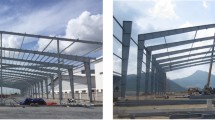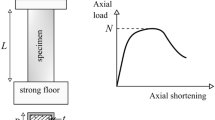Abstract
The web tapered I-section steel (WTIS) columns have been widely used in civil and industrial steel structures. However, the existing theoretical and empirical equations demonstrate a significant discrepancy in estimating the critical axial load of the WTIS columns. This study aims to develop effective artificial neural networks (ANNs) for predicting the critical buckling load of the WTIS columns. A database of 269 finite element models of WTIS columns was generated, after verifying with experimental results, to develop the ANN model. The results of the proposed ANN model were also compared with those of existing formulas, highlighting that the ANN model in this study predicts the critical buckling load of the WTIS columns more accurately than the existing formulas. Moreover, the influences of input parameters on the critical buckling load of the WTIS columns were thoroughly investigated. An ANN-based formula, which considers input variables, was thereafter proposed to estimate the critical buckling load of the WTIS columns. Additionally, a graphical user interface tool has been developed for simplifying the design practice of the WTIS columns.


























Similar content being viewed by others
References
Adeli, H. (2001). Neural networks in civil engineering: 1989–2000. Computer-Aided Civil and Infrastructure Engineering, 16(2), 126–142.
Andalib, Z., Kafi, M. A., Kheyroddin, A., & Bazzaz, M. (2014). Experimental investigation of the ductility and performance of steel rings constructed from plates. Journal of Constructional Steel Research, 103, 77–88.
Andalib, Z., Kafi, M. A., Kheyroddin, A., Bazzaz, M., & Momenzadeh, S. (2018). Numerical evaluation of ductility and energy absorption of steel rings constructed from plates. Engineering Structures, 169, 94–106.
ANSYS. (2018). Workbench v18. 1 User's manual. Ansys Inc.
Antony, J. (2014). Design of experiments for engineers and scientists. Elsevier.
Bani-Hani, K., & Ghaboussi, J. (1998). Nonlinear structural control using neural networks. Journal of Engineering Mechanics, 124(3), 319–327.
Baptista, A., & Muzeau, J. (1998). Design of tapered compression members according to Eurocode 3. Journal of Constructional Steel Research, 46, 146–148.
Bazzaz, M., Andalib, Z., Kafi, M. A., & Kheyroddin, A. (2015a). Evaluating the performance of OBS-CO in steel frames under monotonic load. Journal of Earthquakes and Structures, 8(3), 697–710.
Bazzaz, M., Andalib, Z., Kheyroddin, A., & Kafi, M. A. (2015b). Numerical comparison of the seismic performance of steel rings in off-centre bracing system and diagonal bracing system. Journal of Steel and Composite Structures, 19(4), 917–937.
Bazzaz, M., Kafi, M. A., Kheyroddin, A., Andalib, Z., & Esmaeili, H. (2014). Evaluating the seismic performance of off-centre bracing system with circular element in optimum place. International Journal of Steel Structures, 14(2), 293–304.
Bazzaz, M., Kheyroddin, A., Kafi, M. A., & Andalib, Z. (2012). Evaluation of the seismic performance of off-centre bracing system with ductile element in steel frames. Steel & Composite Structures, 12(5), 445–464.
CEN, N. (2005). 1-1-Eurocode 3: Design of steel structures-Part 1–1: General rules and rules for buildings. European Committee for Standardization.
Chaabene, W. B., Flah, M., & Nehdi, M. L. (2020). Machine learning prediction of mechanical properties of concrete: Critical review. Construction and Building Materials, 260, 119889.
Chatterjee, S., Sarkar, S., Hore, S., Dey, N., Ashour, A. S., Shi, F., et al. (2017). Structural failure classification for reinforced concrete buildings using trained neural network based multi-objective genetic algorithm. Structural Engineering and Mechanics, 63(4), 429–438.
Chojaczyk, A. A., Teixeira, A. P., Neves, L. C., Cardoso, J. B., & Soares, C. G. (2015). Review and application of artificial neural networks models in reliability analysis of steel structures. Structural Safety, 52, 78–89.
Ermopoulos, J. C. (1997). Equivalent buckling length of non-uniform members. Journal of Constructional Steel Research, 42(2), 141–158.
Fausett, L. V. (2006). Fundamentals of neural networks: architectures, algorithms and applications. Pearson Education India.
Fu, F. (2020). Fire induced progressive collapse potential assessment of steel framed buildings using machine learning. Journal of Constructional Steel Research, 166, 105918.
Galambos, T. V. (1998). Guide to stability design criteria for metal structures. John Wiley & Sons.
Genel, K. (2004). Application of artificial neural network for predicting strain-life fatigue properties of steels on the basis of tensile tests. International Journal of Fatigue, 26(10), 1027–1035.
Guarize, R., Matos, N., Sagrilo, L., & Lima, E. (2007). Neural networks in the dynamic response analysis of slender marine structures. Applied Ocean Research, 29(4), 191–198.
Hadi, M. N. (2003). Neural networks applications in concrete structures. Computers & Structures, 81(6), 373–381.
Hirt, M. A., & Crisinel, M. (2001). Traité de Génie Civil (Vol. 11). Presses Polytechniques et Universitaires Romandes.
Hozjan, T., Turk, G., & Srpčič, S. (2007). Fire analysis of steel frames with the use of artificial neural networks. Journal of Constructional Steel Research, 63(10), 1396–1403.
Le, L. M., Ly, H.-B., Pham, B. T., Le, V. M., Pham, T. A., Nguyen, D.-H., et al. (2019). Hybrid artificial intelligence approaches for predicting buckling damage of steel columns under axial compression. Materials, 12(10), 1670.
Lee, G., Morrell, M., & Ketter, R. (1972). Design of tapered members, WRC bulletin, no. 173. Welding Research Council.
Li, Q. (2008a). Stability of non-uniform columns under the combined action of concentrated follower forces and variably distributed loads. Journal of Constructional Steel Research, 64(3), 367–376.
Li, X.-X. (2008). Design of tapered beam-columns. In Proceedings of the 2008 annual stability conference, Tennessee, USA.
Ly, H.-B., Le, L. M., Duong, H. T., Nguyen, T. C., Pham, T. A., Le, T.-T., et al. (2019a). Hybrid artificial intelligence approaches for predicting critical buckling load of structural members under compression considering the influence of initial geometric imperfections. Applied Sciences, 9(11), 2258.
Ly, H.-B., Le, T.-T., Le, L. M., Tran, V. Q., Le, V. M., Vu, H.-L.T., et al. (2019b). Development of hybrid machine learning models for predicting the critical buckling load of I-shaped cellular beams. Applied Sciences, 9(24), 5458.
Ly, H.-B., Pham, B. T., Le, L. M., Le, T.-T., Le, V. M., & Asteris, P. G. (2020). Estimation of axial load-carrying capacity of concrete-filled steel tubes using surrogate models. Neural Computing and Applications, 33, 3437.
Marques, L., Da Silva, L. S., & Rebelo, C. (2014a). Rayleigh Ritz procedure for the determination of the critical load of tapered columns. Steel and Composite Structures, 16(1), 45–58.
Marques, L., da Silva, L. S., Rebelo, C., & Santiago, A. (2014b). Extension of EC3-1-1 interaction formulae for the stability verification of tapered beam-columns. Journal of Constructional Steel Research, 100, 122–135.
Marques, L., Taras, A., da Silva, L. S., Greiner, R., & Rebelo, C. (2012). Development of a consistent buckling design procedure for tapered columns. Journal of Constructional Steel Research, 72, 61–74.
Mathworks, I. (2018). MATLAB and statistics toolbox release 2018b. Natick.
Montgomery, D. C. (2017). Design and analysis of experiments. John Wiley & Sons.
Naser, M., Thai, S., & Thai, H.-T. (2020). Evaluating structural response of concrete-filled steel tubular columns through machine learning. Journal of Building Engineering, 34, 101888.
Naumes, J. C. (2009). Biegeknicken und Biegedrillknicken von Stäben und Stabsystemen auf einheitlicher Grundlage. RWTH Aachen.
Nguyen, D.-D., Tran, V.-L., Ha, D.-H., Nguyen, V.-Q., & Lee, T.-H. (2021). A machine learning-based formulation for predicting shear capacity of squat flanged RC walls. Structures, 29, 1734–1747.
Nguyen, M.-S.T., Thai, D.-K., & Kim, S.-E. (2020). Predicting the axial compressive capacity of circular concrete filled steel tube columns using an artificial neural network. Steel and Composite Structures, 35(3), 415–437.
Nikbin, I. M., Rahimi, S., & Allahyari, H. (2017). A new empirical formula for prediction of fracture energy of concrete based on the artificial neural network. Engineering Fracture Mechanics, 186, 466–482.
Petersen, C. (1993). Stahlbau. Wiesbaden, Vieweg Verlag.
Rafiq, M., Bugmann, G., & Easterbrook, D. (2001). Neural network design for engineering applications. Computers & Structures, 79(17), 1541–1552.
Raftoyiannis, I. G., & Ermopoulos, J. C. (2005). Stability of tapered and stepped steel columns with initial imperfections. Engineering Structures, 27(8), 1248–1257.
Saffari, H., Rahgozar, R., & Jahanshahi, R. (2008). An efficient method for computation of effective length factor of columns in a steel gabled frame with tapered members. Journal of Constructional Steel Research, 64(4), 400–406.
Serna, M., Ibáñez, J., & López, A. (2011). Elastic flexural buckling of non-uniform members: Closed-form expression and equivalent load approach. Journal of Constructional Steel Research, 67(7), 1078–1085.
Simões da Silva, L., Simões, R., & Gervásio, H. (2010). Design of Steel Structures. ECCS Press and Ernst & Sohn.
Tankova, T., Martins, J. P., da Silva, L. S., Simões, R., & Craveiro, H. D. (2018). Experimental buckling behaviour of web tapered I-section steel columns. Journal of Constructional Steel Research, 147, 293–312.
Tran, V.-L., & Kim, S.-E. (2020a). Efficiency of three advanced data-driven models for predicting axial compression capacity of CFDST columns. Thin-Walled Structures, 152, 106744.
Tran, V.-L., & Kim, S.-E. (2020b). A practical ANN model for predicting the PSS of two-way reinforced concrete slabs. Engineering with Computers 1–25.
Tran, V.-L., Thai, D.-K., & Kim, S.-E. (2019a). Application of ANN in predicting ACC of SCFST column. Composite Structures, 228, 111332.
Tran, V.-L., Thai, D.-K., & Kim, S.-E. (2019b). A new empirical formula for prediction of the axial compression capacity of CCFT columns. Steel and Composite Structures, 33(2), 181–194.
Tran, V.-L., Thai, D.-K., & Nguyen, D.-D. (2020). Practical artificial neural network tool for predicting the axial compression capacity of circular concrete-filled steel tube columns with ultra-high-strength concrete. Thin-Walled Structures, 151, 106720.
Vanluchene, R., & Sun, R. (1990). Neural networks in structural engineering. Computer-Aided Civil and Infrastructure Engineering, 5(3), 207–215.
Author information
Authors and Affiliations
Corresponding author
Ethics declarations
Conflict of interest
The authors declare that they have no conflicts of interest.
Additional information
Publisher's Note
Springer Nature remains neutral with regard to jurisdictional claims in published maps and institutional affiliations.
Rights and permissions
About this article
Cite this article
Nguyen, TH., Tran, NL. & Nguyen, DD. Prediction of Critical Buckling Load of Web Tapered I-Section Steel Columns Using Artificial Neural Networks. Int J Steel Struct 21, 1159–1181 (2021). https://doi.org/10.1007/s13296-021-00498-7
Received:
Accepted:
Published:
Issue Date:
DOI: https://doi.org/10.1007/s13296-021-00498-7




